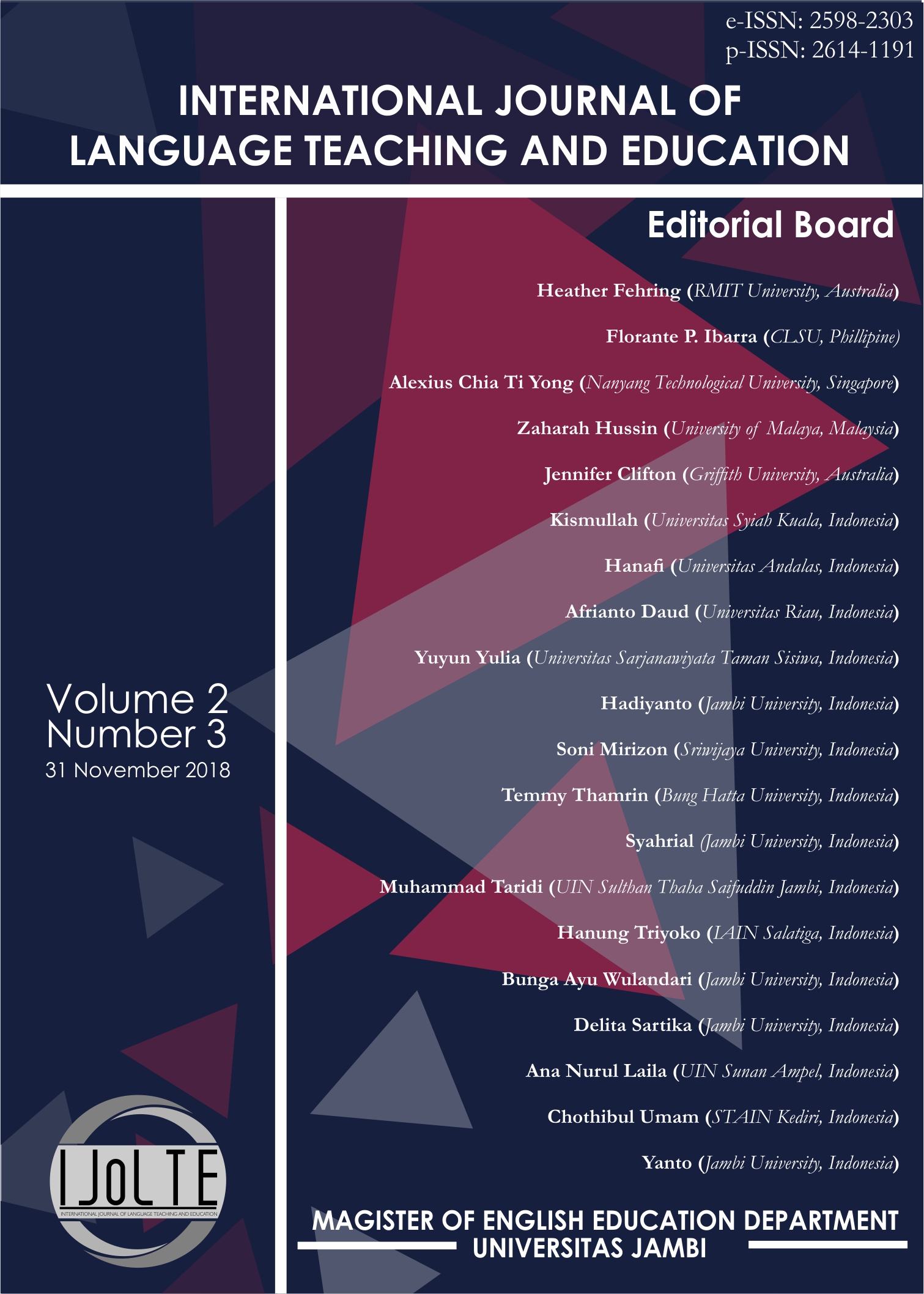Analysis of Students' English Reading Comprehension through KWL (Know-Want-Learn) Learning Strategies
DOI:
https://doi.org/10.22437/ijolte.v2i3.5641Keywords:
English Reading Comprehension, Know-Want-Learn Learning StrategiesAbstract
This research aims to know the reading comprehension of students through KWL learning strategies. The research is descriptive research survey. The subject of research is the student of Mathematics Education Program who learned English. A sample of this research used sampling Simple Random Sampling (n = 40). Data collection is done by carrying out a test of reading using the test, after the students being treated by KWL learning strategies. Analysis of research data using descriptive statistical techniques. The results showed that on the item reserved text reading comprehension there is 75% of the students who were able to resolve the matter at this stage determine the topic, 62.5% of the students were only able to resolve the matter at this stage determine the word citation and 67.5% of students were able to determine at the conclusion of the recitation and 50% specify detail information. It can be concluded that the KWL strategy is able to improve students reading comprehension. Key Words: Know-Want-Learn Learning Strategies, Reading Comprehension, English.
Downloads
References
[2] Tyler, R. (1994). Children Construction of Explanation in Science. Victoria: Deakin Uni-versity
[3] Rubin, D. (1983). Writing and Reading The Vital Arts. New York: Mcmillan Publishing Co., Inc.
[4] Abdulrab,A. H. M., (2015) “Effectiveness Of KWL-Plus Strategy On Acquisition The Concepts In Science And Attitude Towards Science For Eighth Grade Students.†Inter-national Journal of Innovative Research and Studies, Vol. 4 (3)
[5] Rahim, F. (2008). PengajaranMembaca di Sekolah Dasar. Jakarta :BumiAksara.
[6] Tarigan, H. G. (2008). Membaca: sebagaiSuatuKeterampilanBerbahasa. Bandung: Angkasa.
[7] Nation, S. P. (2009). Teaching ESL/EFL Reading and Writing. New York. Routledge
[8] Tarigan, H. G. (2008). Membaca: sebagaiSuatuKeterampilanBerbahasa. Bandung: Angkasa
[9] Somadaya, S. (2011). Strategidan Teknik PembelajaranMembaca. Yogyakarta: Gra-haIlmu.
[10] Razak, A. (2005). MembacaPemahamanteoridanAplikasiPengajaran. Pekanba-ru:Autobiografi
[11] Mulyati, Y.dkk. (2007). KeterampilanBerbahasa Indonesia SD. Jakarta :Universitas Terbuka
[12] Djiwandono,S. (2008). Tes Bahasa. Jakarta: PT Indeks
[13] Somadaya, S. (2011). Strategidan Teknik PembelajaranMembaca. Yogyakarta: Gra-haIlmu.
[14] Nazir, M. (2005). MetodePenelitian . Jakarta: PT Ghalia Indonesia
[15] Ogle, D. (1986) K-W-L: A Teaching Model That Develops Active Reading of Expository Text. The Reading Teacher, 39, 564-570. http://dx.doi.org/10.1598/RT.39.6.11
[16] Rahim, F. (2008). PengajaranMembaca di Sekolah Dasar. Jakarta :BumiAksara
[17] Riswanto., Risnawati., Deti,.(2014). The Effect of Using KWL (Know, Want, Learned) Strategy on EFL Students’ Reading Comprehension Achievement. International Journal of Humanities and Social Science. Vol. 4, No. 7(1)
[18] Dieu, Tran Thi Thanh. (2015). Trying K-W-L Strategy on Teaching Reading Compre-hension to Passive Students in Vietnam. International Journal of Language and Linguis-tics. Vol. 3, No. 6, 2015, pp. 481-492.
Downloads
Published
Versions
- 2018-12-01 (1)
- 2018-12-01 (1)
How to Cite
Issue
Section
License
The Authors submitting a manuscript do so on the understanding that if accepted for publication, copyright of the article shall be assigned to International Journal of Language Teaching and Education (IJoLTe) and Magister Program of English Education Department, Universitas Jambi as publisher of the journal. Copyright encompasses rights to reproduce and deliver the article in all form and media, including reprints, photographs, microfilms, and any other similar reproductions, as well as translations.
IJoLTe keep the rights to articles that have been published. And, the authors are permitted to disseminate published article by sharing the link of IJoLTe' website. Authors are allowed to use their works for any purposes deemed necessary without written permission from IJoLTe with an acknowledgement of initial publication in this journal.
IJoLTe and Magister Program of English Education Department, Universitas Jambi, and the Editors make every effort to ensure that no wrong or misleading data, opinions or statements be published in the journal. In any way, the contents of the articles and advertisements published in IJoLTe are the sole and responsibility of their respective authors and advertisers.
If the article was jointly prepared by more than one author, any authors who submitting the manuscript warrants that he/she has been authorized by all co-authors to be agreed on this copyright and license notice (agreement) on their behalf, and agrees to inform his/her co-authors of the terms of this policy. IJoLTe will not be held liable for anything that may arise due to the author(s) internal dispute. IJoLTe will only communicate with the corresponding author.
By submitting the article/manuscript to this journal, the authors agree with this policy and consciously agree that IJoLTe does not provide royalties or other fees to the authors for their published articles. By agreeing this policy, IJoLTe ensures that published articles are publicly accessible and will be free of charge for the readers. No specific document sign-off is required.
Users of this website will be licensed to use materials from this website following the Creative Commons Attribution 4.0 International License. Please use the materials accordingly
You are free to:
- Share — copy and redistribute the material in any medium or format
- Adapt — remix, transform, and build upon the material for any purpose, even commercially.
- The licensor cannot revoke these freedoms as long as you follow the license terms.








1.png)
